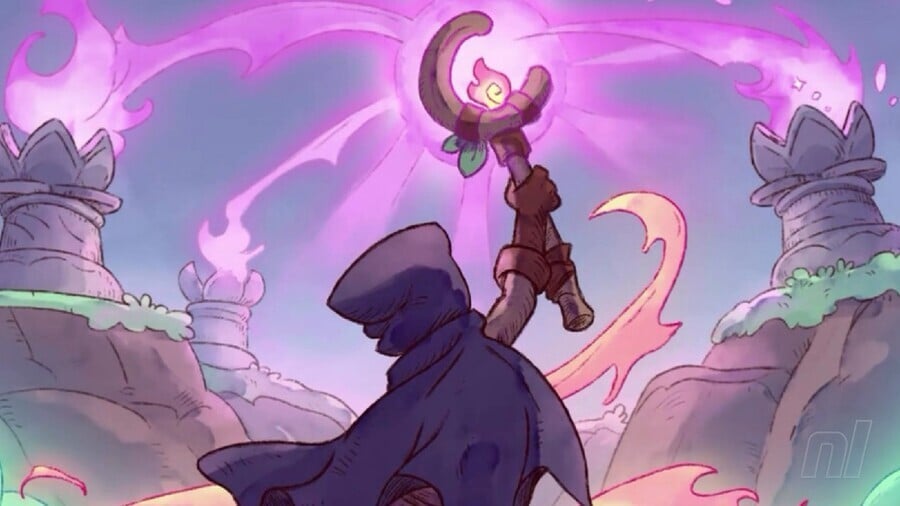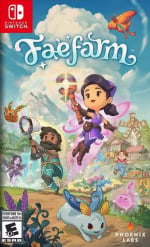On this page: Beginner's Tips
1. Finish Chapter 4 ASAP 2. Making money 3. Invest in fast travel 4. Use that map 5. Make the most of your time 6. Sorting storage woes 6.1. Sorting 6.2. Storing 6.3. Shortcuts 7. Breed, baby, breed! 8. Pay attention to the seasons Beginner's Tips
Finish Chapter 4 ASAP
The first few chapters might seem surprisingly dull, and you'll probably find yourself wondering why this relatively normal farming game has the word "fae" in the title at all. This will be made clearer once you finish the first four chapters, which open up the world much more than before.
It's a bit of a pain, but that means you'll have to reach the bottom of the Saltwater Mines as quickly as possible. Make that your main goal for a while, even at the cost of investing in crops and animals, and you'll find the game gets much more interesting, with magical powers, a new jump ability, a new world to explore, and more characters unlocked, too!
Making money
While we don't have a guide to making money just yet, we can give you a few simple tips. The real dosh isn't in crops, meals, animals, or crafts — it's in the mines. Specifically, it's in the gems in the mines, which you can polish using the Gem Polisher workbench to net a nice profit. Level up your pickaxe and your mining skills, or supplement it with food that increases mining skill, and each gem node will drop even more gems, racking up a tidy profit. Gems that are further down in the mines, or in harder mines that unlock through the story, are worth even more.
Shipping Contracts are a good way to make more profit off your items... that is, if they work. We could only get them to work about half the time. But the profit margin on the items that the Shipping Contracts ask for is higher than just selling them normally, and saves you space in the market, too. You'll unlock the Shipping Contracts after finishing the Saltwater Mines, and they can be found just south-west of town.
Because your sell slots are limited, you generally want to sell stuff that costs a lot individually. In the early game, eggs, wool, and critter drops are not too bad, but it really will benefit you to unlock the Floating Ruins ASAP (by finishing Chapter 4), or at the very least, having an easy warp down to the lower levels of Saltwater Mines. And on that note...
Invest in fast travel
Fae Farm's fast travel system requires seals, which can be crafted at the Seal Crafting Station. Each seal will take a few bits of ore and a few gems, which are found in the mines, usually at about the depth that starts to get hard for your current level.
The Wayshrines are easy enough to unlock with one-off seals, but the mines themselves feature a fast-travel system between floors that allow you to skip to where you were before. These seals are harder to craft, and you'll need to know exactly how many you need of each kind before heading into the mine, lest you end up seal-less. The Saltwater Mines tend to require 6 of each seal, but later mines are different, so keep an eye on what each floor requires!
And trust us: these seals are worth investing in before anything else that requires ore and gems. Fast travel will save you a hell of a headache, especially because the fast-travel menu tells you the likelihood of encountering a given material on each floor.
Use that map
You can open your map and select any NPC to get a tracker arrow that will lead you directly to them. From the map, you can also see if they have a quest for you — although most of these will be friendship and romance quests, or job quests. Main quests and festival quests appear as a diamond with an exclamation mark inside, so check up on those as soon as you see them!
Make the most of your time
The time in Fae Farm is pretty generous — we'd estimate a day takes about 20-30 minutes — but if you're not careful, you could end up wasting a ton of that time in menus. The clock will only pause some of the time, and you need to keep an eye on it to make sure you know when those times are.
For example, opening the main menu pauses the clock, but your inventory doesn't. In fact, you can still be hit by enemies with your inventory open, so if you need to take potions or eat food, make sure you're out of range first. Talking to people and shopping pauses the menu, but going into buildings and selling items at the market doesn't. Using crafting tables also doesn't pause the menu, and neither does building on your farm, decorating your house, or having the decor menus open.
A trick we found in the later game was crafting Zoom Potions, which let you move around faster, and we recommend using the main menu to pause whenever you need to.
Sorting storage woes
Why can't games get storage systems right? We just want a bottomless cupboard, accessible at all times, with smart sorting, player-friendly UI, and free tea and biscuits on request. Is that so hard?
Fae Farm's storage system does not have all those things, but it's still pretty darn good — you just have to know how to use it. Your best friends in terms of the storage UI are going to be these three things:
1. Sorting
Figure out the ZL and ZR menus in the storage interface and you'll be well on your way to always finding the object you need in your gigantic pile of stuff.
ZR sorts by either type, or alphabetically — useful in some situations, but usually not a massive help if you don't know the name of something, or can't remember your ABCs without singing the little song. ZL, on the other hand, allows you to filter by category. These include things like farming (seeds, crops, and fertilizer); alchemy (potions & ingredients); foraging (anything you picked up off the ground); and refined goods (ingots, cloth, but NOT lumber — that's in raw materials instead).
Unfortunately, you can't sort your inventory. If it bothers you that your items are all over the place, you can drop them and pick them up again, which will put them back in the top slots, or select individual items and choose "move" to put them somewhere tidier.
2. Storing
Press RB to store everything in your inventory that already has at least one counterpart in your storage. This makes it super easy to drop off everything from mines, fishing, or general adventures in one go. You can use LB to store individual stacks as well.
3. Shortcuts
You don't have to go into the menu to access your inventory — just press up on the D-pad to open your pockets immediately. Simple!
Breed, baby, breed!
Breeding in Fae Farm is simple, but time-consuming. Buy an animal at one of the farms west of town, register it at home, and then bring it back to the same farm to get it bred.
Why? Because an animal bred from your own animals will have a larger happiness meter, allowing you to reach higher heights by taking care of it. Which... we think... makes them drop more resources. But it might not. The animal raising aspect of the game is a little confusing.
Pay attention to the seasons
There are four seasons in Fae Farm — spring, summer, autumn, winter — and each one brings with it new critters, new fish, new forageables, and new crops. The game doesn't do a fantastic job of telling you this, so we're telling you this now.
For example, each season has its own wild greens. Spring has arugula, summer has dandelion, autumn has red chard, and winter, collard greens. These greens are all basically the same when it comes to cooking, but they appear differently, and you'll need to pick them all to fill out your almanac, if that's important to you.
The mushrooms and nuts that appear in the Spooky Forest are the same, as well as the shellfish in the Saltwater Mines, the berries on bushes, and the forageables in the fae and winter areas later in the game. Make sure to check back to unlock them all in the almanac!
Head to the second page for even more tips...


